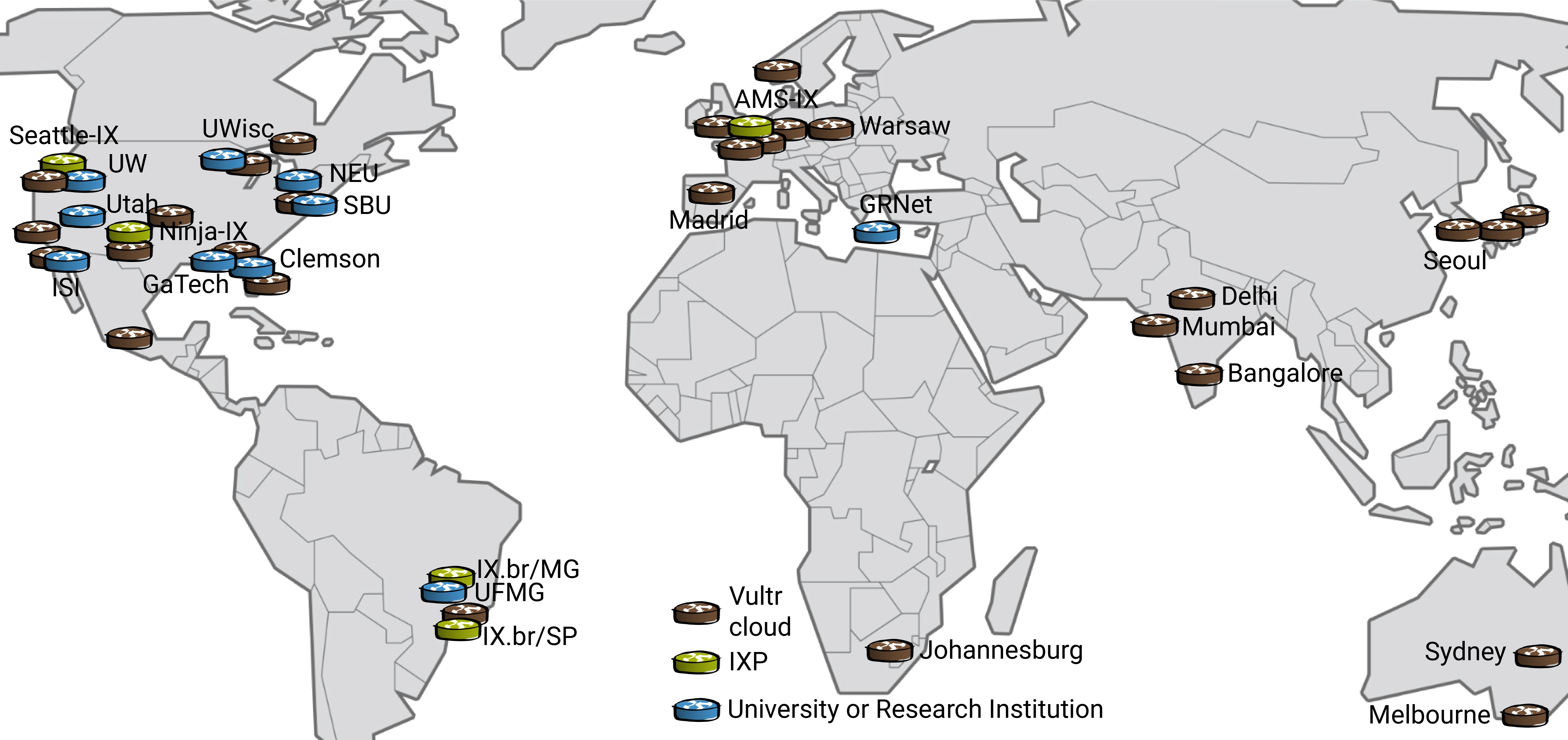About PEERING
What is PEERING
PEERING is a system that provides safe and easy access for researchers and educators to the Internet's BGP routing system, enabling and inspiring transformational research. The system is in part funded by grants from NSF, Google, and GENI. The project, from Columbia University, University of Southern California and Universidade Federal de Minas Gerais (and, formerly, Princeton University), fosters Internet research and innovation. Traditionally, the barriers to conduct Internet routing experiments hindered progress. Most research on interdomain routing is either based on passive observation of existing routes, which cannot capture how the Internet will respond to changes in protocols or policies, or based on simulations, whose fidelity is restricted by known limitations in our understanding of Internet topology and policy. To move beyond these limited experimental approaches, the PEERING testbed connects (via BGP) with real networks at universities and Internet exchange points around the world. Instead of being observers of the Internet ecosystem, researchers become participants, running experiments that announce/select routes and send/receive traffic directly with these networks. The testbed can multiplex multiple simultaneous research experiments, each of which independently makes routing decisions and sends and receives traffic. Researchers can submit proposals to use PEERING. PEERING has enabled research that appeared at top academic and industrial conferences. Without this testbed, none of this research would have been evaluated on the actual Internet, blunting its impact.
Infrastructure and Connectivity
PEERING operates hardware servers and virtual machines running our BGP virtualization stack. PEERING has routers at universities, research institutions, IXPs, and the Vultr cloud provider. At IXP and cloud sites, experiments can control which of the thousands of IXP / cloud peers receive which BGP announcements from the experiment, influencing inbound traffic to the experiment. Researchers can also control via which site traffic from the experiment reaches the Internet and, at IXP sites, can control via which peer it reaches the Internet. The picture below provides an overview of the PEERING infrastructure.

Objectives
The long-term goal of the PEERING system is to enable on-demand, safe, and controlled access to the Internet routing ecosystem for researchers and educators:
- PEERING for researchers. Today, it is hard for researchers to conduct Internet routing experiments. To perform a routing experiment, a research institution has to obtain Internet resources (IP addresses and ASNs) and establish relations with upstream networks. PEERING eliminates these obstacles and provides researchers controlled on-demand access to the routing ecosystem.
- PEERING for educators. Educators can use the PEERING infrastructure in teaching students the Internet routing architecture.
Result Publication
The core results of the experiments using PEERING must be published in publicly accessible documents. Detailed data produced by experiments, such as ping and traceroute command outputs, must be shared with researchers in accredited higher education institutions.
Experimentation Practices and Conditions
The Internet routing system supports connectivity for people worldwide. The PEERING testbed ensures that experiments produce no noticeable impact on the Internet. PEERING applies the following rules to all experiments:
- Prefix origination. The PEERING testbed will announce only prefixes allocated to the testbed or to researchers using the testbed. This condition ensures that the testbed can only affect traffic destined to PEERING IP addresses. The testbed filters announcement of any other prefix.
- Autonomous System origination. The PEERING system will only announce BGP messages with AS-PATHs that start with the AS numbers allocated to the testbed or to researchers using it.
- Update rate. The PEERING system will limit the rate of BGP messages, such that each BGP peer of the system will receive at most 10 announcements per hour for each PEERING prefix.
- Opt-out policy. Where possible, an experiment must offer to remote networks an opt-out option. For instance, if the experiment is measuring reachability to networks in the Internet, such networks should be given an opt-out policy. The opt-out must be offered in the Internet operator forums, such as NANOG mailing list.
Please see guidelines on how to submit an experiment and our complete Acceptable Use Policy.
Technical Coordination
The PEERING testbed is operated by researchers at Columbia University, University of Southern California, and Universidade Federal de Minas Gerais. In a very unlikely event of PEERING sending BGP announcements that are not consistent with the policies described above, please email the team immediately, at noc at peering.ee.columbia.edu.
ASNs and IP Resources
- ASNs:
- We establish all peering sessions from AS 47065.
- We control 7 additional ASNs: 61574, 61575, 61576, 263842, 263843, 263844, 33207.
- In most cases, any of our 7 ASNs can originate announcements for the prefixes listed below.
- Prefixes:
We control 3 IPv4 prefixes, and 1 IPv6 prefix:- 184.164.224.0/19
- 138.185.228.0/22
- 204.9.168.0/22
- 2804:269c::/32